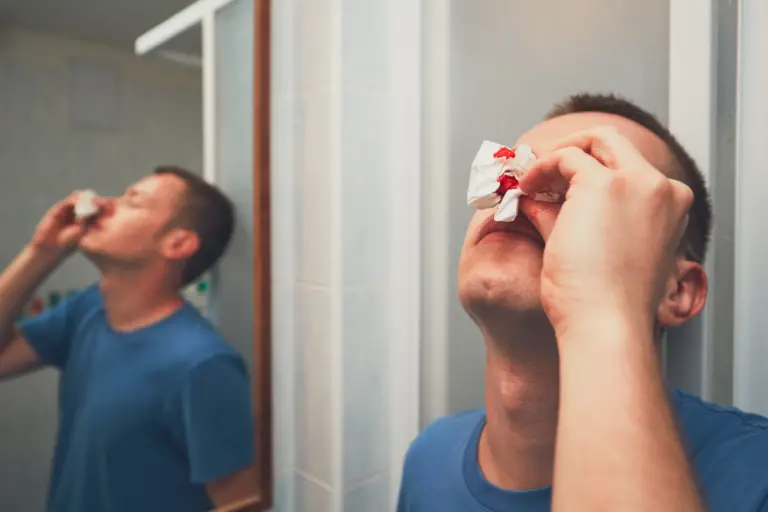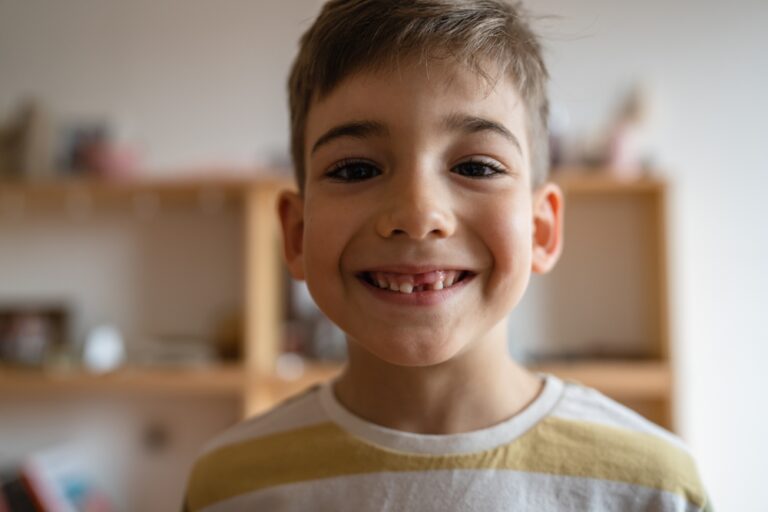If you want to keep your dog healthy and away from the vets, then regularly brushing their teeth is going to be an important step. Dental issues are common for dog owners and can be avoided with good oral hygiene.
But if you’re new to the world of doggie tooth brushing, then you probably have plenty of questions one of them being how often to brush dogs’ teeth. Not only will we answer that question but we’ll also look at why they need clean teeth and much more. Let’s get started!
How Often to Brush Dogs Teeth
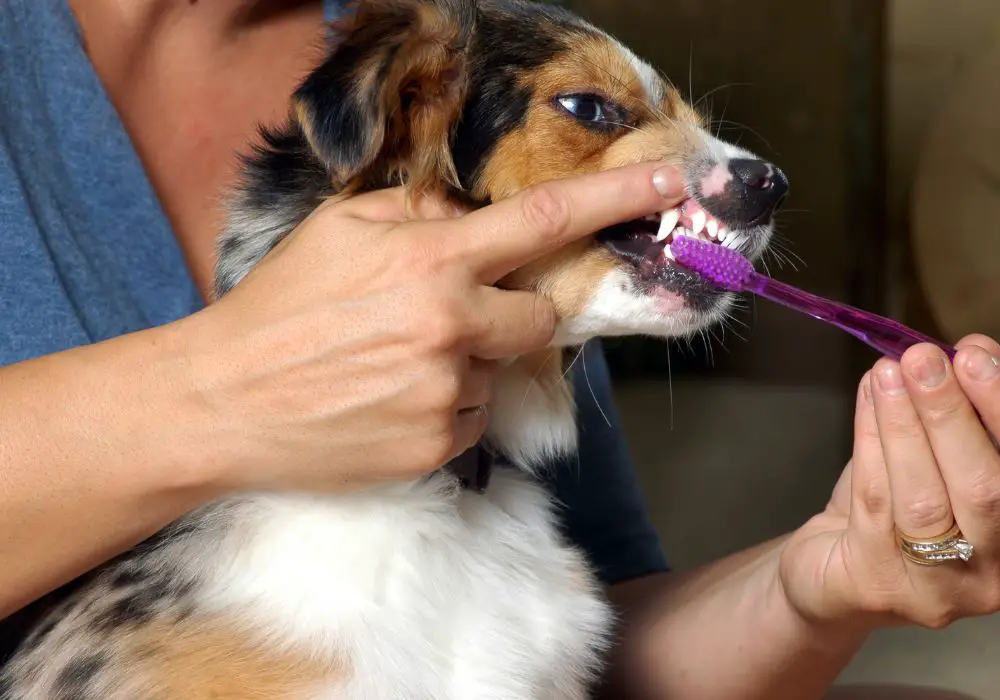
Opinion on this varies between what you should be doing and the minimum recommended brushing you can get away with. Ideally, you should be brushing your dog’s teeth at least once a day, with many vets recommending that they should be brushed twice daily.
While that is the ideal solution, in reality, you’ll be able to prevent a lot of dental issues by brushing just two or three times a week. Along with brushing, you can also use plenty of dental toys, chews, and other products to keep their teeth in perfect shape.
How often you brush them is up to you, but you shouldn’t let their teeth have a build-up of plaque and tartar. If you’re brushing their teeth on most days, then don’t feel guilty about skipping a day as dogs don’t have as much acid on their teeth as we do.
Why Do Dogs Need to Have Their Teeth Brushed?
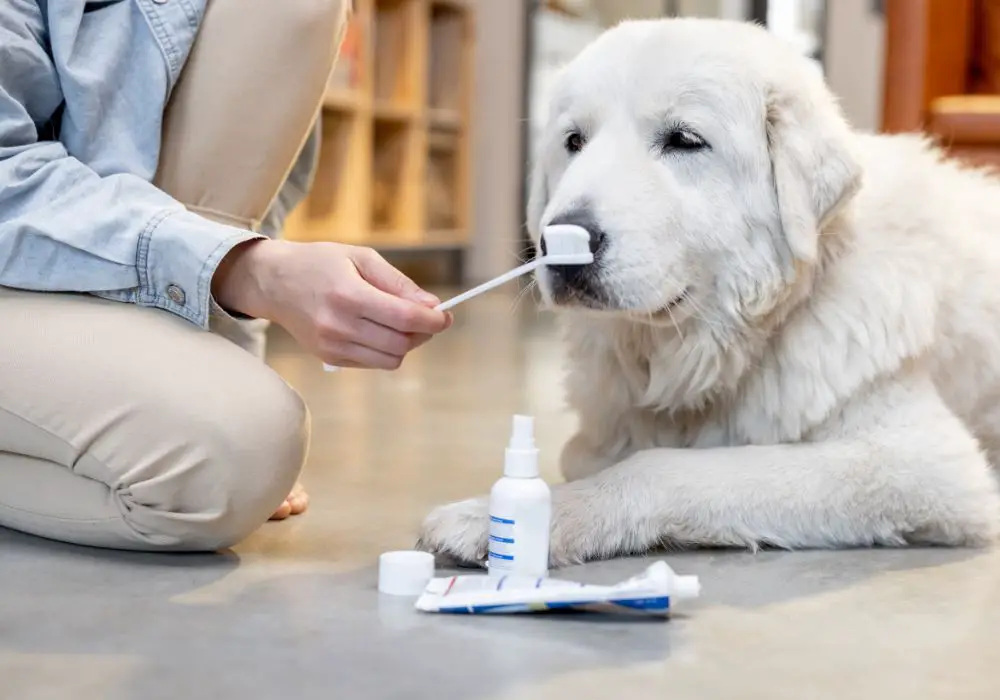
Many people presume that a dog’s teeth don’t need to be brushed at all, and it’s a fair assumption to make. After all, these domesticated pets are descended from wild animals so surely they can naturally clean their own teeth, right?
The answer is a little complicated and it mostly comes down to diet. Wild animals, such as a wolf, for example, has a diet that has little to no carbohydrates as they are carnivores. Therefore, they are unlikely to have cavities or gum disease.
The reason is that carbohydrates contain sugar. The bacteria in a dog’s (and ours) mouth love to feast on sugars and when they do, they’ll release acid. It’s this acid that can create cavities and the bacteria can quickly grow and cause diseases.
In dog food, there is usually a high concentration of carbohydrates and therefore it gives the bacteria in their mouth something to eat. It’s because of this that teeth need to be brushed every now and again.
A dog’s teeth don’t need to be brushed as often as a human’s, partly because we eat a lot of refined sugar such as in candy, desserts, and sweetened drinks. Also, dogs have more gaps in their teeth so it’s less likely for sugary food to be trapped between them.
How To Clean a Dogs Teeth
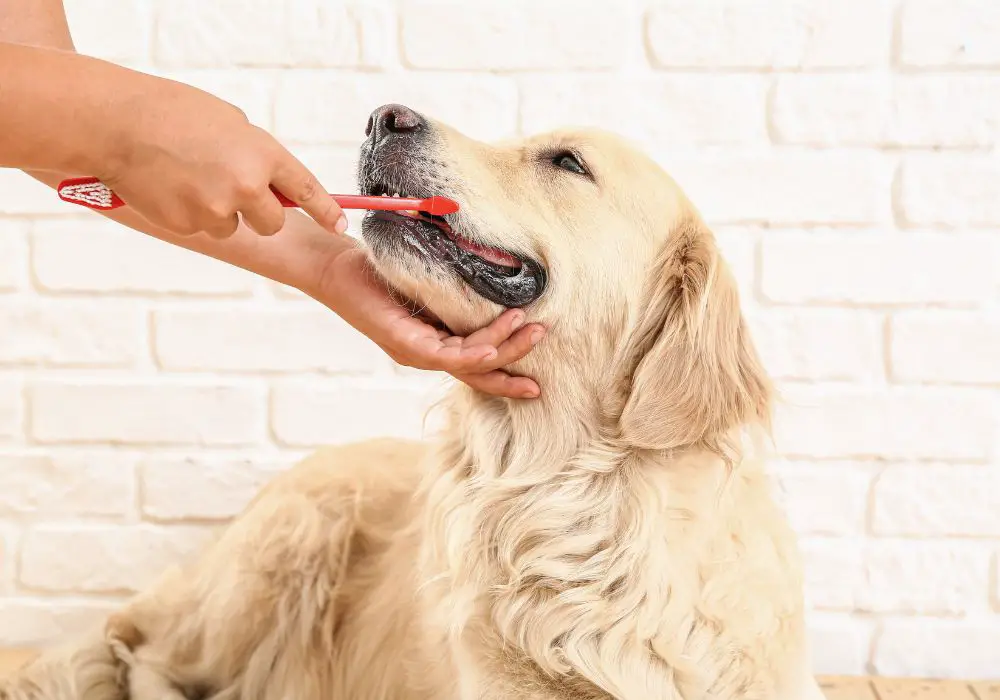
Now you know how often you should be cleaning a dog’s teeth, how are you meant to do it? This is something that many people struggle with. It can be hard to keep your dog still let alone being able to put a brush in their mouth. Here’s how to do it.
Step 1
The first step involves no brushing at all as it’s all about getting your dog in the best position for brushing. Here you’ll want to teach them to place their chin in your non-dominant hand so that you can brush with your other hand.
The best way to do this is by showing them a treat before lowering it down so that their chin rests on your outstretched palm. You can then give them the treat until they start to understand they’ll get a treat once they adopt this behavior.
Eventually, they will start to do this behavior automatically, so you have control over their jaw. Over time you can gradually delay and remove the treat until they place their chin in your hand when you hold out your palm without expecting a treat.
Step 2
The next step is to get them comfortable with you touching their mouth and the taste of toothpaste. It’s good to start by touching their lips before progressing to touching their gums. It’s important to note that you don’t need to put your hand inside their mouth.
This may be a gradual process as your dog gains your trust and both you and them get comfortable with what you’re doing. Now is also a good time to introduce some toothpaste to your fingers so they get used to the taste.
Step 3
Now you can progress to brushing their teeth and this is not much different from how you brush your own teeth. Most people prefer to use a toothbrush made specifically for dogs but you also have the option of buying a thimble which you place over your finger.
You’ll most likely need to lift up their upper lip to access their top jaw and you can brush in a circular motion to get rid of the plaque. Don’t worry about washing their mouth out as a dog’s toothpaste can be swallowed, as it’s not the same as the toothpaste we use.
Signs of Dental Problems
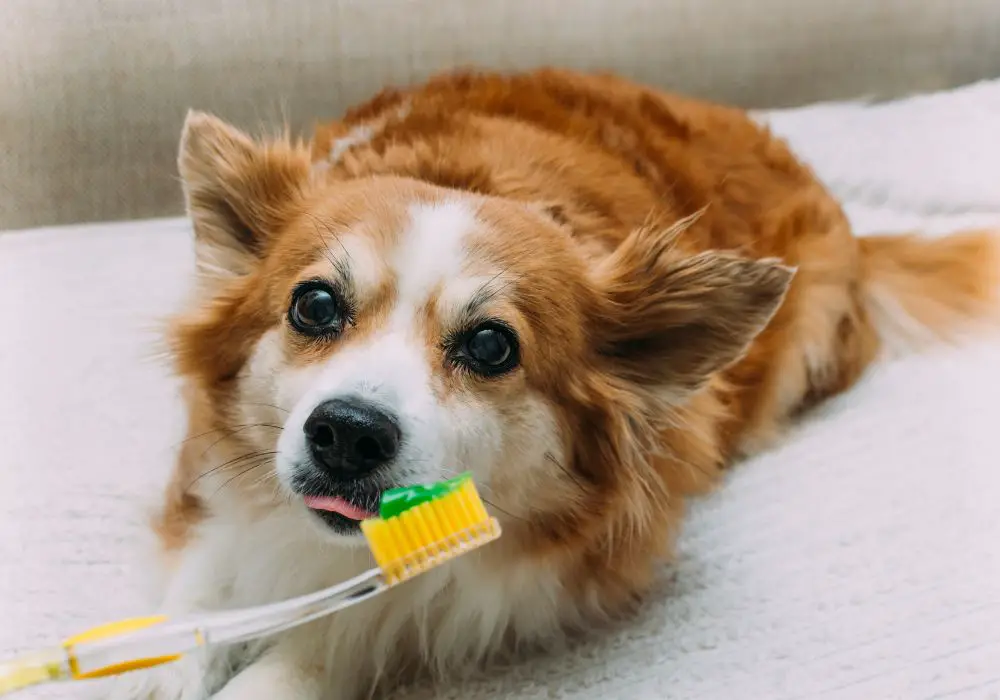
If your dog’s teeth haven’t been brushed for a long time, then you may be worried they may already be experiencing some dental issues. If this is something you’re concerned about, here are some signs to look out for.
- Visual Inspection – The easiest thing to do is a visual inspection of their teeth. A dog’s teeth should look like ours. They should be white with no cavities and no discoloration. Often dogs will have a build-up of tartar on their teeth.
- Bad Breath – Another easy sign to notice is bad breath. A bad smell is often caused by bacteria, and possibly an infection. If the bad smell remains after you have brushed their teeth, then it’s best to take them to the vet.
- Loss of Appetite – Refusing food is a common sign of tooth pain. If their loss of appetite last for more than a day or so then it needs to be investigated. It’s worth noting that this can be a symptom of many health issues and not just dental problems.
- Bleeding Gums – Sometimes bleeding isn’t a huge concern as it is often caused by little accidents such as them cutting themselves on a chew toy. But if the bleeding is prolonged or excessive, get them seen as it can be an indicator of a disease or another issue such as mouth trauma.
- Swollen Gums – Another clear sign of dental issues is if the gums are swollen. If there is an infection not only will they swell, but the gums will often turn a deep red color. Serious infections may involve swelling in other areas of the jaw.
- Excessive Drooling – Drooling is common in dogs but you’ll know how much your pet drools and what is normal for them. If their drooling is excessive then it could be a big indicator they are in pain and not comfortable with closing their mouths.
- Irritable Behavior – If you notice irritable behavior or them acting out of the ordinary, they may be in pain. As with loss of appetite, this can also be a symptom of a wide range of health conditions or other factors.
How To Keep Their Teeth Healthy
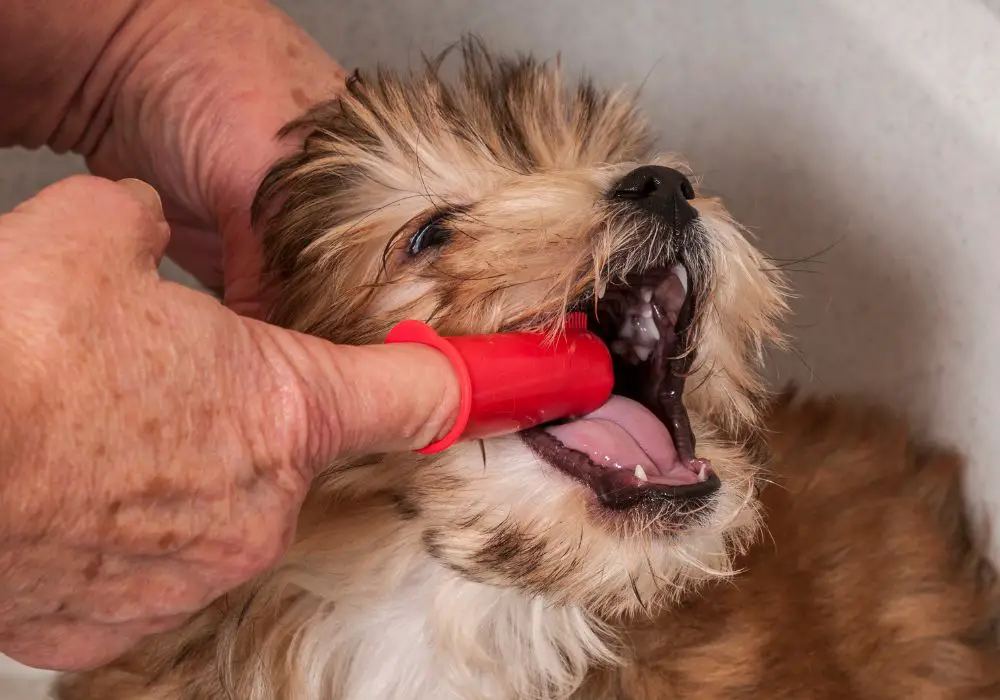
We’ve already established how important brushing is to your dog’s dental health, but how else can you keep their teeth strong and healthy? Thankfully there are many tools and tricks that you can use between those brushes.
One of the best things you can do is use dental toys or chews. Toys allow them to bite away happily as it is designed to scrape against their teeth. Chews work in the same way as they are shaped to rub away any plaque that is on their teeth.
Giving them bones also works in the same way, but suitable bones can be hard to acquire and there is a choking risk. Another great idea is to add supplements or additives to their food or water, which can help to soften their plaque.
Don’t want to be caught short without a brush and toothpaste? You can also carry either dental wipes, sprays, or gels. These can help you wipe away any plaque from their teeth to prevent a build-up.
While these are all excellent ideas, it’s important to note they are not a replacement for brushing. However, when they are used alongside brushing, they can ensure they have excellent oral health for their entire life.
Conclusion
How often to brush dogs’ teeth? Well, there’s not one conclusive answer and it can depend on their diet and the condition of their teeth. At a minimum, you should be brushing two or three times a week but try and do it every day.
If you are worried about dental issues then look out for the symptoms above and contact your vet if you have any concerns. With good oral hygiene and plenty of brushing, hopefully, you never need to visit the vet about their precious teeth.


